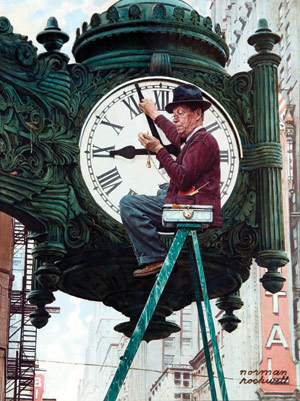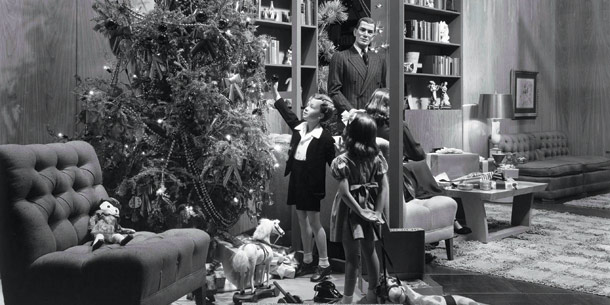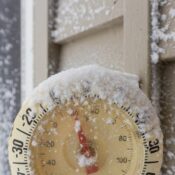Christmas has not been celebrated at Chicago’s Marshall Field’s department stores since 2005, but mention the name to just about any Windy City native, and it will plunge them back into the childhood wonder of the flagship downtown shopping emporium during the holiday season. Gazing up at the towering evergreen of the Walnut Room, glittering ornaments weighing on its boughs. Winding through lines for Cozy Cloud Cottage, waiting for a moment with Santa. Marveling at the elaborate holiday windows along State Street, and savoring that first bite of a Marshall Field’s Frango Mint, made just upstairs in the on-site candy kitchen.
Cynics may dismiss these memories as mere reflections of cold retail strategies. But for Chicagoans, the emotional connections are real, as they are for shoppers across the country who cherished the family-owned department stores that anchored their downtowns. Bostonians had Filene’s. Atlantans had Rich’s. Detroiters had Hudson’s. Clevelanders had Halle’s. Philadelphians had Wanamaker’s. Though conceived primarily as commercial centers, they evolved into larger institutions of American life — places where families of various castes and classes were welcome to take in the spectacle of services and goods, no admission fee required.
At no time was this truer than the holiday season. And before the age of online shopping and franchise-heavy megamalls sent them to their demise (Marshall Field’s, for one, was converted into a Macy’s), these stores held a significant place in our collective Christmas memories.
But how did these houses of retail come to inspire such fond feelings?
That’s the question that I, as a historian, became fascinated by growing up in Chicago, where Marshall Field’s was as much a part of the soul of the city as our Lakefront or our Cubs. As a child, I would meet my grandmother under the famous clock at State Street and Washington Boulevard and head up to the Walnut Room for lunch with my grandfather, who worked at Field’s as the buyer for the linen department for 25 years. When the change to Macy’s was announced, protestors gathered under the clock with signs reading “Field’s is Chicago — Boycott Macy’s.” They have been picketing there every fall since 2005. Last year’s signs read, “If the Cubs can win the World Series, Marshall Field’s can come back to Chicago.”
Christmas wasn’t much of a holiday anywhere in America when Potter Palmer arrived in Chicago in 1852 and opened a dry goods store. By the turn of the century, his successors, Marshall Field and Levi Leiter, had built it into the premiere department store in the Midwest, known for impeccable customer care, generous return policies, quality merchandise, and a vast array of services (from tea rooms to relaxation rooms, shoe repair to hotel bookings — all of which kept shoppers in the building and reaching for their wallets).
Christmas, however, had received only modest attention. The store eventually began advertising Christmas cards and gift merchandise, and in 1885, they opened a seasonal toy department (which later became year-round). The first mention of holiday decorations at Marshall Field and Company came in 1907. The store had just opened in a monumental new building featuring the Walnut Room, and restaurant employees reportedly put up a small Christmas tree.
By 1934, the tree stood 25 feet high. By mid-century, Field’s laid claim to the world’s largest indoor Christmas conifer: a 45-foot evergreen hoisted atop the Walnut Room’s drained fountain. It took 18 decorators and three-story-high scaffolding to trim the live evergreen. To kids, it looked like it stretched all the way up to the sky.
Through the decades, department stores like Marshall Field’s employed ever more elaborate strategies to lure shoppers. As the smell of Mrs. Hering’s Chicken Pot Pie wafted from the Walnut Room, massive “ice” reindeer soared over displays, oversized candy canes and evergreen garlands wound down the aisles, and giant stars and mega snowflakes floated in the skylight. In dizzying displays of holiday spirit, Field’s insides conveyed top-to-bottom Yuletide joy.
And then there were the Marshall Field’s gift boxes. Each one bore the elegant calligraphy of the company name, signaling that the gift inside was worth savoring. It was not unheard of for gift-givers to repurpose the notoriously sturdy containers, packing them with “impostor” goods from other stores, both out of frugality and in an effort to impart that ineffable Field’s glow.
Field’s had good reason to continue these traditions. But their real power came from transcending their original commercial purpose. For many Chicagoans, Marshall Field’s at Christmas was transformed from a wonderfully stocked department store into a near-sacred family ritual.
None of these rituals was more legendary than the holiday windows.
In 1910, thanks to improved glass manufacturing that could create massive transparent panels, stores across the U.S. began mounting elaborate window displays, and efforts quickly escalated as they became a powerful lure for shoppers.
Marshall Field’s inventive window designer, Arthur Fraser, used the big corner window at Washington Boulevard to showcase holiday gift merchandise. His first panel featured animated carousels and gift-ready toy trains. But in 1944, the store’s new stylist, John Moss, ditched the hard sell in favor of narrative windows — re-creating Clement Moore’s A Visit from St. Nicholas. The story panels were such a hit they were repeated the next year.
Soon, a new holiday window trend took hold: store-specific mascots. Montgomery Ward’s claimed Rudolph the Red-Nosed Reindeer, and Wieboldt’s concocted the Cinnamon Bear. Not to be outdone, one of Moss’s co-designers, Joanna Osborn, conjured Uncle Mistletoe, a plump, Dickens-like figure decked out in a red greatcoat and black top hat. With white wings, he flew around the world, teaching children the importance of kindness at Christmas.

The first window displays of Uncle Mistletoe went up in 1946 in a series titled A Christmas Dream, which featured the generous old man bringing a young boy and girl to the North Pole to visit Santa. In 1948, Uncle Mistletoe got some company in the form of Aunt Holly, and the pair became a merchandizing bonanza. Over the years, shoppers could buy dolls, books, ornaments, coloring sets, molded candles, cocktail napkins, hot pads, puppets, glassware, and even used window props.
As time went on, Field’s window decorators mastered the art of fake snow (a combination of kosher salt and ground-up glass) and detailed animatronic antics. I remember when the windows had a Nutcracker theme. Below the big scenes depicting the main store were tiny windows where tiny mice figurines were enacting their own delightful version of the story.
At their peak, planning and designing the annual displays began more than a year in advance, with an eager public waiting every November for the reveal of each new theme. Tens of thousands of fans made pilgrimages from Illinois, Iowa, Indiana, Michigan, Wisconsin, and Minnesota to crowd around the earnest State Street displays in childlike awe.
There was a marketing aspect to the windows, of course. Delighted viewers, suffused with the seasonal spirit, would hopefully pop inside to shop. But there was no commerce in the displays themselves. Like many of the holiday creations inside, people became attached to the spirit, not the sales. The store’s brand became more than just the goods it sold, which ebbed and flowed over the years. For generations of Chicago families, Marshall Field’s simply inspired Christmas cheer.
Leslie Goddard is a historian and the author of Remembering Marshall Field’s (Arcadia, 2011). Her family has more than 50 years’ experience working for Marshall Field’s. This essay is part of What It Means to Be American, a partnership of the Smithsonian’s National Museum of American History and Zócalo Public Square.
This article is featured in the November/December 2017 issue of The Saturday Evening Post. Subscribe to the magazine for more art, inspiring stories, fiction, humor, and features from our archives.
Become a Saturday Evening Post member and enjoy unlimited access. Subscribe now




Comments
Did Marshall Fields send decorations and decorators to private estates in the south?
I’m surely missing the windows as I’m now in California. But in my possession I have Marshall Fields Rapunzel from – I believe – 1986 when the window theme was boxing day theater, an English tradition of attending live theater the day after Christmas. The windows each had a fairytale such as Cinderella, Rapunzel, etc. The nursery school I worked for received the castle, Rapunzel and the prince to use as a puppet theater when they were cleaning out old window decor cluttering the store room in 2003. They didn’t want the figures and had already tossed the prince but I was able to save Rapunzel. Her motor still works where her hands move up and down her braid, helping the prince climb up (when he was there!) She hold a prominent place in my Christmas decor of course!
I am looking for Christmas depictions with stuffed figures possibly the Twelve Days of Christmas, The were already very old when I saw I saw them in the 40ties in Milwaukee
This is a wonder nostalgic article. I loved Marshal Fields.